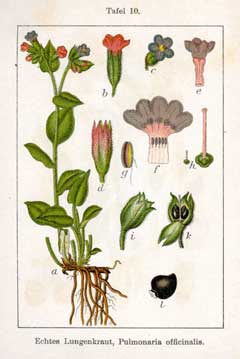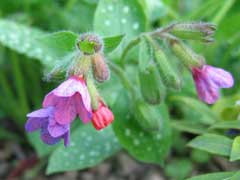 |
|
http://commons.wikimedia.org/wiki/File:Pulmonaria_officinalis_Sturm10.jpg |
 |
| http://commons.wikimedia.org/wiki/User:Fabelfroh |
Translate this page:
Summary
Bloom Color: White. Main Bloom Time: Late spring, Mid spring. Form: Rounded, Spreading or horizontal.
Physical Characteristics

 Pulmonaria officinalis is an evergreen Perennial growing to 0.3 m (1ft) by 0.3 m (1ft in) at a fast rate.
Pulmonaria officinalis is an evergreen Perennial growing to 0.3 m (1ft) by 0.3 m (1ft in) at a fast rate.
See above for USDA hardiness. It is hardy to UK zone 4 and is not frost tender. It is in leaf all year, in flower from March to May, and the seeds ripen from May to June. The species is hermaphrodite (has both male and female organs) and is pollinated by Bees, flies.
It is noted for attracting wildlife.
Suitable for: light (sandy), medium (loamy) and heavy (clay) soils and can grow in heavy clay soil. Suitable pH: mildly acid, neutral and basic (mildly alkaline) soils. It can grow in full shade (deep woodland) or semi-shade (light woodland). It prefers moist soil and can tolerate drought.
UK Hardiness Map
US Hardiness Map
Synonyms
P. maculosa.
Plant Habitats
Woodland Garden Dappled Shade; Shady Edge; not Deep Shade; Ground Cover; Hedgerow;
Edible Uses
Edible Parts: Leaves
Edible Uses:
Leaves - raw or cooked[2, 7, 8, 9, 105]. They can be added to salads or used as a potherb[183]. A fairly bland flavour but the leaves are low in fibre and make an acceptable addition to mixed salads, though their mucilaginous and slightly hairy texture make them less acceptable when eaten on their own[K]. The young leaves make a palatable cooked vegetable[244], though we have found the texture to be somewhat slimy[K]. The plant is an ingredient of the drink Vermouth[244].
References More on Edible Uses
Medicinal Uses
Plants For A Future can not take any responsibility for any adverse effects from the use of plants. Always seek advice from a professional before using a plant medicinally.
Astringent Demulcent Diaphoretic Diuretic Emollient Expectorant Homeopathy Ophthalmic
Resolvent
Lungwort has a high mucilage content and this makes it useful in the treatment of chest conditions, being of particular benefit in cases of chronic bronchitis[254]. It combines well with other herbs such as coltsfoot (Tussilago farfara) in the treatment of chronic coughs including whooping cough and can also be taken to treat asthma[254]. The leaves and flowering shoots are astringent, demulcent, diaphoretic, diuretic, emollient, mildly expectorant and resolvent[4, 7, 9, 21, 165]. They are often used for their healing effect in pulmonary complaints[4] and their mucilaginous nature makes them beneficial in treating sore throats[244]. The leaves can also be used externally to stop bleeding[254]. They are harvested in the spring and dried for later use[7]. A distilled water made from the plant is an effective eyewash for tired eyes[7]. A homeopathic remedy is made from the plant[9]. It is used in the treatment of bronchitis, coughs and diarrhoea[9].
References More on Medicinal Uses
The Bookshop: Edible Plant Books
Our Latest books on Perennial Plants For Food Forests and Permaculture Gardens in paperback or digital formats.

Edible Tropical Plants
Food Forest Plants for Hotter Conditions: 250+ Plants For Tropical Food Forests & Permaculture Gardens.
More

Edible Temperate Plants
Plants for Your Food Forest: 500 Plants for Temperate Food Forests & Permaculture Gardens.
More

More Books
PFAF have eight books available in paperback and digital formats. Browse the shop for more information.
Shop Now
Other Uses
A tolerant and slow growing ground cover plant for open woodland and border edges[197, 200]. Plants should be spaced about 50cm apart each way[208].
Special Uses
Attracts Wildlife Food Forest Ground cover
References More on Other Uses
Cultivation details
Landscape Uses:Border, Container, Ground cover, Massing, Specimen, Woodland garden. Grows well in any moderately good soil including heavy clay soils[1, 31]. Prefers full to part shade in a moist humus rich soil[200]. Succeeds in the sunless shade of buildings[200]. Plants growing in shady positions tolerate drought if the soil is rich in humus[190]. The leaves tend to wilt in hot weather when the plant is grown in full sun[190]. Hardy to about -20°c[187]. Members of this genus are rarely if ever troubled by browsing deer and rabbits[233]. A valuable early nectar source for bees[200]. There are several named forms, selected for their ornamental value[233]. Hybridizes freely with other members of this genus[200]. Special Features:
Not North American native, Extended bloom season in Zones 9A and above.
References Carbon Farming Information and Carbon Sequestration Information
Temperature Converter
Type a value in the Celsius field to convert the value to Fahrenheit:
Fahrenheit:
The PFAF Bookshop
Plants For A Future have a number of books available in paperback and digital form. Book titles include Edible Plants, Edible Perennials, Edible Trees,Edible Shrubs, Woodland Gardening, and Temperate Food Forest Plants. Our new book is Food Forest Plants For Hotter Conditions (Tropical and Sub-Tropical).
Shop Now
Plant Propagation
Seed - sow spring in a greenhouse. When they are large enough to handle, prick the seedlings out into individual pots and grow them on in the greenhouse for their first winter. Plant them out into their permanent positions in late spring or early summer, after the last expected frosts. Division in spring or autumn or after flowering in early summer if the soil is not too dry[200]. Very easy, larger divisions can be planted out direct into their permanent positions. We have found that it is better to pot up the smaller divisions and grow them on in light shade in a cold frame until they are well established before planting them out in late spring or early summer.
Other Names
If available other names are mentioned here
Native Range
EUROPE: Denmark, Sweden (south), Austria, Belgium, Switzerland, Czech Republic, Germany, Hungary, Luxembourg, Netherlands, Poland, Slovakia, Russian Federation (European part), Moldova, Ukraine (west), Albania, Bulgaria, Greece (north), Croatia, Italy, Montenegro, Romania, Serbia, Slovenia, France
Weed Potential
Right plant wrong place. We are currently updating this section.
Please note that a plant may be invasive in one area but may not in your area so it's worth checking.
Conservation Status
IUCN Red List of Threatened Plants Status :

Growth: S = slow M = medium F = fast. Soil: L = light (sandy) M = medium H = heavy (clay). pH: A = acid N = neutral B = basic (alkaline). Shade: F = full shade S = semi-shade N = no shade. Moisture: D = dry M = Moist We = wet Wa = water.
Now available:
Food Forest Plants for Mediterranean Conditions
350+ Perennial Plants For Mediterranean and Drier Food Forests and Permaculture Gardens.
[Paperback and eBook]
This is the third in Plants For A Future's series of plant guides for food forests tailored to
specific climate zones. Following volumes on temperate and tropical ecosystems, this book focuses
on species suited to Mediterranean conditions—regions with hot, dry summers and cool, wet winters,
often facing the added challenge of climate change.
Read More
Expert comment
Author
L.
Botanical References
17200
Links / References
For a list of references used on this page please go here
Readers comment
| Add a comment |
|
If you have important information about this plant that may help other users please add a comment or link below. Only comments or links that are felt to be directly relevant to a plant will be included. If you think a comment/link or information contained on this page is inaccurate or misleading we would welcome your feedback at [email protected]. If you have questions about a plant please use the Forum on this website as we do not have the resources to answer questions ourselves.
* Please note: the comments by website users are not necessarily those held by PFAF and may give misleading or inaccurate information.
To leave a comment please Register or login here All comments need to be approved so will not appear immediately.
|
Subject : Pulmonaria officinalis
|
|
|
|